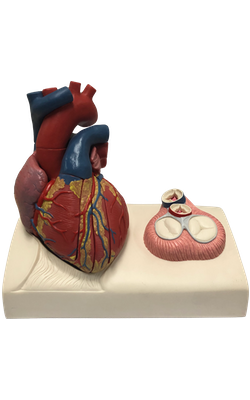Main Model

Common carotid artery

Arteries in Anterior Cervical Region
The anterior cervical region contains the carotid system of arteries, consisting of the common carotid artery and its terminal branches, the internal and external carotid arteries. It also contains the IJV, its tributaries, and the anterior jugular veins. The common carotid artery and one of its terminal branches, the external carotid artery, are the main arterial vessels in the carotid triangle. Branches of the external carotid (e.g., the superior thyroid artery) also originate in the carotid triangle. Each common carotid artery ascends within the carotid sheath with the IJV and vagus nerve to the level of the superior border of the thyroid cartilage. Here, each common carotid artery terminates by dividing into the internal and external carotid arteries. The internal carotid artery has no branches in the neck; the external carotid has several.
The right common carotid artery begins at the bifurcation of the brachiocephalic trunk. The right subclavian artery is the other branch of this trunk. From the arch of the aorta, the left common carotid artery ascends into the neck. Consequently, the left common carotid has a course of approximately 2 cm in the superior mediastinum before entering the neck.
The internal carotid arteries are direct continuations of the common carotids superior to the origin of the external carotid artery, at the level of the superior border of the thyroid cartilage. The proximal part of each internal carotid artery is the site of the carotid sinus. The carotid body is located in the cleft between the internal and the external carotid arteries. The internal carotid arteries enter the cranium through the carotid canals in the petrous parts of the temporal bones and become the main arteries of the brain and structures in the orbits. No named branches arise from the internal carotid arteries in the neck.
The external carotid arteries supply most structures external to the cranium; the orbit and the part of the forehead and scalp supplied by the supra-orbital artery are the major exceptions. There is some deep distribution as well (e.g., via the middle meningeal artery). Each external carotid artery runs posterosuperiorly to the region between the neck of the mandible and the lobule of the auricle, where it is embedded in the parotid gland, and terminates by dividing into two branches, the maxillary artery and the superficial temporal artery. Before these terminal branches, six arteries arise from the external carotid artery:
1. Ascending pharyngeal artery: arises as the first or second branch of the external carotid artery and is its only medial branch. It ascends on the pharynx deep (medial) to the internal carotid artery and sends branches to the pharynx, prevertebral muscles, middle ear, and cranial meninges.
2. Occipital artery: arises from the posterior aspect of the external carotid artery, superior to the origin of the facial artery. It passes posteriorly, immediately medial and parallel to the attachment of the posterior belly of the digastric muscle in the occipital groove in the temporal bone, and ends by dividing into numerous branches in the posterior part of the scalp. During its course, it passes superficial to the internal carotid artery and CN IX - CN XI.
3. Posterior auricular artery: a small posterior branch of the external carotid artery, which is usually the last preterminal branch. It ascends posteriorly between the external acoustic meatus and mastoid process to supply the adjacent muscles; parotid gland; facial nerve; and structures in the temporal bone, auricle, and scalp.
4. Superior thyroid artery: the most inferior of the three anterior branches of the external carotid artery, runs antero-inferiorly deep to the infrahyoid muscles to reach the thyroid gland. In addition to supplying this gland, it gives off branches to the infrahyoid muscles and SCM and gives rise to the superior laryngeal artery, supplying the larynx.
5. Lingual artery: arises from the anterior aspect of the external carotid artery, where it lies on the middle pharyngeal constrictor. It arches supero-anteriorly and passes deep to the hypoglossal nerve (CN XII), the stylohyoid muscle, and the posterior belly of the digastric muscle. It disappears deep to the hyoglossus muscle, giving branches to the posterior tongue. It then turns superiorly at the anterior border of this muscle, bifurcating into the deep lingual and sublingual arteries.
6. Facial artery: arises anteriorly from the external carotid artery, either in common with the lingual artery or immediately superior to it. After giving rise to the ascending palatine artery and a tonsillar artery, the facial artery passes superiorly under cover of the digastric and stylohyoid muscles and the angle of the mandible. It loops anteriorly and enters a deep groove in and supplies the submandibular gland. It then gives rise to the submental artery to the floor of the mouth and hooks around the middle of the inferior border of the mandible to enter the face.
Memory device for the six branches of the carotid artery: 1-2-3 - one branch arises medially (ascending pharyngeal), two branches arise posteriorly (occipital and posterior auricular), and three branches arise anteriorly (superior thyroid, lingual, and facial).